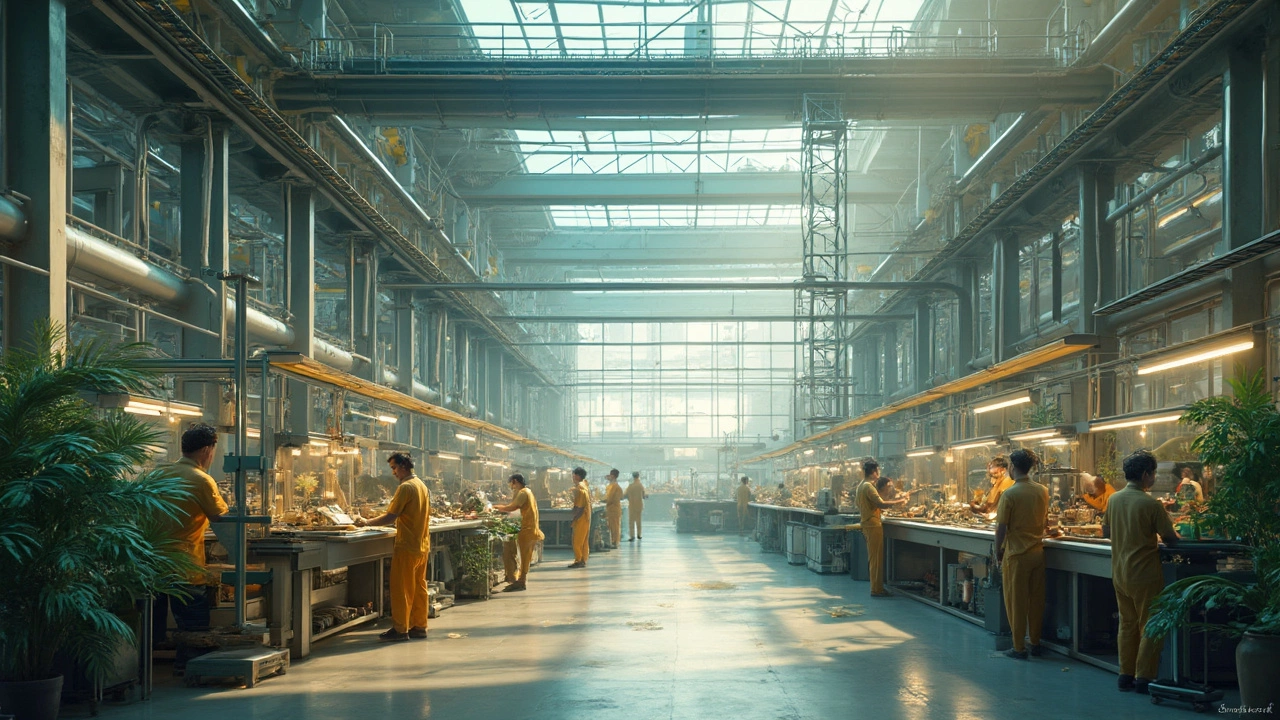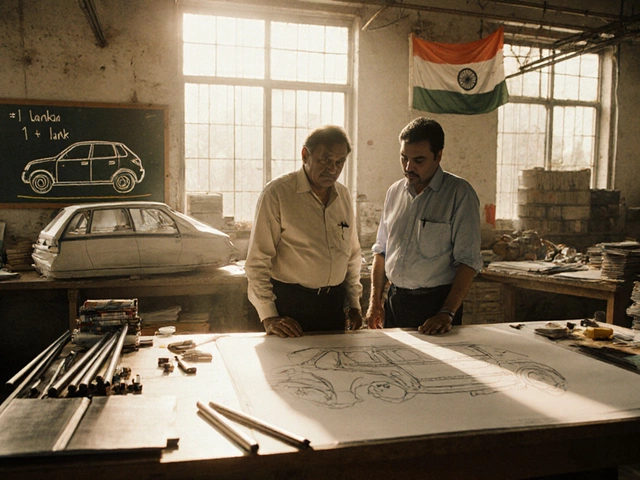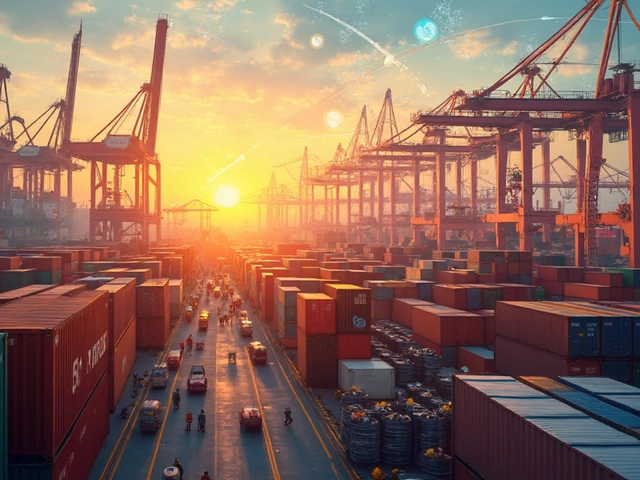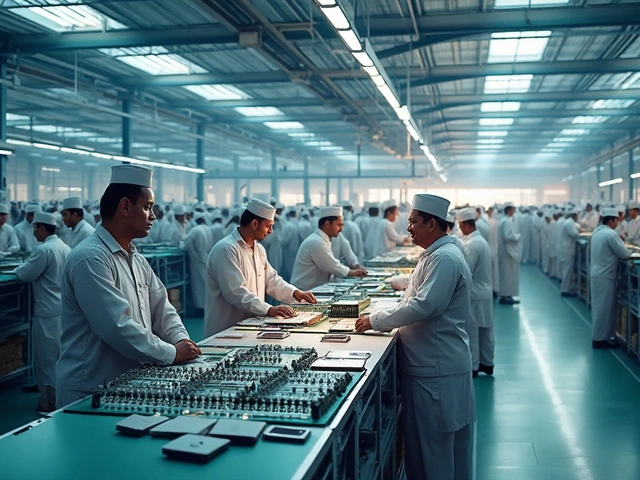Alright, so we're smack in the middle of 2025, and if you're curious about what industries are booming right now, you're in for a treat. Manufacturing's got some exciting developments that are hard to ignore. Imagine factories churning out products while being more eco-friendly than ever. Yup, the rise of green manufacturing is not just some distant dream; it's happening!
We've also got automation and AI making waves, turning old-school manufacturing into a high-tech carnival. Robots on assembly lines aren't just for sci-fi movies anymore; they're saving costs and reducing errors in real life. And let's not forget 3D printing – it's like giving your business a superpower to create complex designs without breaking a sweat.
- The Rise of Green Manufacturing
- Automation and AI in Industry
- 3D Printing: A Game Changer
- The Electric Vehicle Boom
- Biotechnology Manufacturing
- Supply Chain Innovations
The Rise of Green Manufacturing
You know what's buzzing in the manufacturing world? Green manufacturing. It's not just a trend; it's turning into a necessity. Companies are eager to reduce their carbon footprint, and everyone's eyes are on sustainable practices. Imagine factories that are not only energy-efficient but also create less waste and use renewable resources. That's the future we're marching toward.
What's driving this shift? Well, for starters, consumers are more aware and choose products that align with their values. They want to know where their stuff comes from and how it impacts the planet. Plus, governments are upping their game with stricter regulations and offering incentives for sustainable practices.
Take a peek at this: A report shows that 80% of companies believe eco-friendly initiatives boost brand reputation and customer loyalty. And in places like Europe, there's a push to have industries cut emissions by at least 50% by 2030.
Let's get into the nitty-gritty. Here's what companies are doing to go green:
- Renewable energy: Using wind, solar, and hydroelectric power reduces reliance on fossil fuels. Think Tesla's Gigafactory in Nevada, running on 100% renewable energy.
- Waste reduction: Implementing zero-waste policies so what's not sold gets reused or recycled rather than trashed. It's like Upcycle City in those factories!
- Eco-friendly materials: Moving from traditional plastics to biodegradable and recyclable options. It's like swapping unhealthy snacks for veggies—instead of feeling guilty, you're making a healthier choice.
These shifts not only help the environment but also save money in the long run. Less energy use means lower bills. Recycling can cut costs on materials. For businesses watching the bottom line, that's a coup.
All in all, green manufacturing looks ready to take off. It's not just an investment in the future; it's an approach that's shaping up to be necessary for surviving in this competitive world. Whether you're in the business or just a curious onlooker, keep your eyes peeled for how these developments unfold.
Automation and AI in Industry
Let's get real—automation and AI are basically on the frontlines of industry transformation in 2025. Gone are the days when these technologies were just buzzwords in tech circles. They're now the backbone of smart factories around the globe, and it's all about working smarter, not harder.
Imagine assembly lines with robots seamlessly performing tasks that once took teams of people. The manufacturing sector is seeing less downtime and more efficiency, thanks to these robotic maestros. In fact, industries that have adopted these systems are reporting productivity increases of up to 20%. That's a big deal when you're crunching numbers.
Artificial Intelligence isn't just about cool gadgets learning stuff. In factories, AI systems are predicting when machines might fail and scheduling maintenance before things go haywire. This predictive maintenance saves a ton on repair costs and keeps production lines humming.
But it's not all about machines stealing the show—automation is also revolutionizing supply chains. Picture AI-driven data analysis providing insights so crisp it tells you exactly when and where to ship products to cut transport costs and meet delivery times.
- Real-time data tracking lets companies monitor every bit of the production process.
- AI algorithms optimize inventory management, reducing waste and shortages.
- Smart chatbots and virtual assistants improve customer service, handling queries and support issues 24/7.
And hey, there's a job angle too. While some fear job losses, the reality is that as these technologies take over routine tasks, humans can focus on creative and complex problem-solving roles that machines can't handle. So, people get to do more meaningful work, leading to a more engaged workforce.
To wrap it up, the automation and AI combo is ushering in an era where industry efficiency skyrockets, leaving businesses that embrace it with a huge competitive edge.
3D Printing: A Game Changer
Alright folks, here's the scoop on why 3D Printing is causing quite the stir in the manufacturing world. It's not just about making cool prototypes anymore; it's transforming how we think about production altogether. You see, traditional manufacturing typically involves cutting away materials or molding them into shape. But 3D Printing, also known as additive manufacturing, builds items layer by layer, which saves material, time, and, yes, money.
What's mind-blowing is that industries ranging from healthcare to aerospace are tapping into this technology. Take, for example, the automotive industry, where companies are using 3D Printing to make lightweight car parts, resulting in better fuel efficiency. Moreover, 3D Printing proves invaluable in medical applications, allowing for customized prosthetics, which previously would have been super expensive and time-consuming to produce.
"3D Printing is revolutionizing manufacturing by providing the ability to create complex designs at a fraction of the cost," says John Smith, CEO of FutureTech Innovations. "This technology empowers creativity and efficiency in unprecedented ways."
Just to give you some idea of its impact, consider this neat little table below showing the expected growth in the sector:
| Year | 3D Printing Market Size (Billions) |
|---|---|
| 2020 | $12 |
| 2025 | $35 |
| 2030 | $63 |
With such promising growth, it's no wonder everyone's jumping on the bandwagon. If you're considering diving into the manufacturing scene, investing in 3D Printing tech could be a savvy move. You'll be stepping into an industry poised for significant growth while being on the cutting edge of innovation. Not too shabby, right?
There you have it—3D Printing is not just changing the game; it's rewriting the rules. It's no longer about if you should get in on this action, but when. And the answer is: right now!

The Electric Vehicle Boom
Welcome to the era of electric vehicles (EVs) taking the world by storm. It's not just a buzzword anymore. By 2025, manufacturing in the EV sector is more than just hot; it’s sizzling! The shift from gas-guzzlers to electric rides is picking up speed, and if you’re eyeing the manufacturing sector, this is where the action’s at.
EV production might have seemed niche a few years back, but today, the story’s different. With governments around the globe throwing their weight behind sustainable solutions, subsidies and incentives have made EV manufacturing a golden opportunity. Global EV sales are projected to reach around 11 million units, doubling the sales from just two years ago. That's a massive wave you don't want to miss.
Now, why is this industry booming? For starters, battery technology is improving. Companies are investing heavily in battery innovations, making EVs more affordable and practical. As a manufacturer, diving into battery production or even components like lightweight metals and specialized software can be highly profitable.
The Electric Vehicle sector is getting more exciting with several players entering the game. Traditional carmakers, tech giants, and even startups are throwing their hats in the ring. This means a rise in jobs, demand for EV parts, and opportunities to provide services like charging infrastructure and software solutions. The landscape is vivid and vast.
| Year | Projected Global EV Sales (Million Units) |
|---|---|
| 2023 | 5.5 |
| 2025 | 11 |
From manufacturing batteries to building the cars themselves, or supplying essential parts, the potential's immense. The need for innovation and adaptability is your playground here. Keep an eye on regulatory changes and technological advancements – they’re happening fast and can open new doors quicker than you think.
If you have a knack for innovation and a desire to contribute to a cleaner planet, setting up shop in the EV industry might just be your calling. It’s a space where the demand's rising, technology's moving forward, and the future's electric – literally!
Biotechnology Manufacturing
If there's one industry that screams 'future,' it's biotechnology manufacturing. This sector's been gaining momentum, thanks to some mind-blowing advancements. From pharmaceuticals to agriculture, the potential is endless.
Think of it like this: in biotech, nature's little secrets get unlocked to solve everyday problems. With advances in genetic engineering, scientists are producing everything from personalized medicines to healthier food crops. No wonder everyone's talking about it!
According to Dr. Elaine Stockton, a leading expert in biotech advancements from the University of Innovation, "Biotechnology is transforming the way we approach traditional manufacturing, bringing cutting-edge solutions to some of the world's pressing issues."
Biotech firms are working on creating more effective vaccines and treatments. Remember the pandemic panic? Well, biotech played a massive role in fast-tracking vaccine development. It's no surprise that investments in this field are skyrocketing.
Let's break down some key areas where biotech manufacturing is making strides:
- Pharmaceuticals: Companies are creating vaccines and therapies using genetic research, making treatments faster and more targeted.
- Food and Agriculture: Genetically modified crops that resist pests and diseases are in the works, aiming for sustainable solutions.
- Environmental Applications: Biodegradable materials developed through biotech can reduce pollution, offering greener alternatives.
If you're considering jumping into this sector, be ready to navigate a landscape that's rich with opportunity but needs a good grasp on science and regulations. Embracing innovation is key, and who knows, you might just stumble upon the next big thing.
Supply Chain Innovations
Let's talk about the nuts and bolts behind all the cool stuff: supply chains. In today's manufacturing landscape, the chain is getting some serious upgrades, thanks mostly to tech advancements. Remember all those times packages took ages? That's becoming old news.
First up, we're seeing the incredible integration of AI and machine learning. These bad boys are predicting demand way better than ever. Imagine knowing exactly how many widgets you need before your customers even know they want them. It saves money, reduces waste, and helps keep the environment cleaner—a win-win!
Blockchain is also kicking in to add some transparency. Ever wondered where your stuff really comes from or whether it's ethically made? Blockchain provides a clear, tamper-proof record of a product’s journey from raw materials to finished goods, increasing trust.
And hey, don't sleep on the Internet of Things (IoT). These smart sensors are making supply chains smarter. They're tracking goods in real-time, notifying you if something's off. Imagine getting alerts the moment a shipment is delayed or a temperature-sensitive package gets too warm. Total lifesaver.
- Real-time tracking and monitoring of shipments
- Predictive analytics for better demand forecasting
- Improved transparency with blockchain
- Reduction of waste and inefficiencies
Interestingly, companies investing in these innovations have seen up to a 20% increase in efficiency. That's not just a small improvement; it’s a game changer. So, if you're eyeing to jump into the industry boom of 2025, keeping up with these supply chain advancements is a must.




